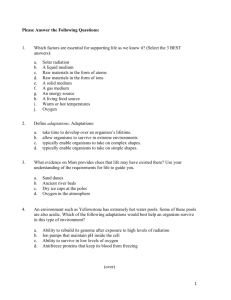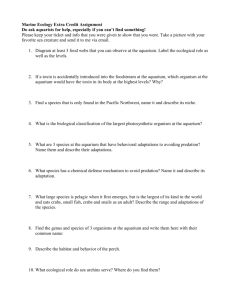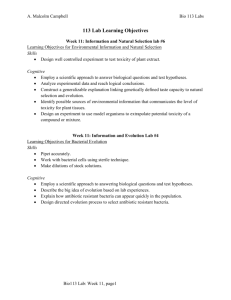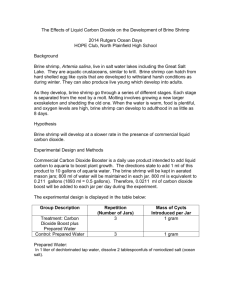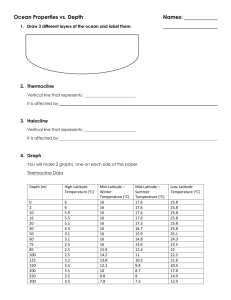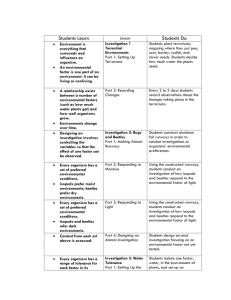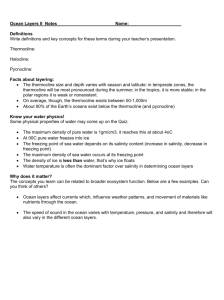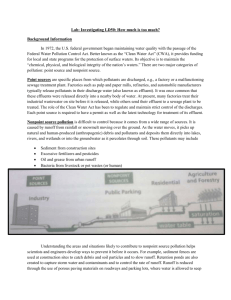Resource Distribution and Predator
advertisement
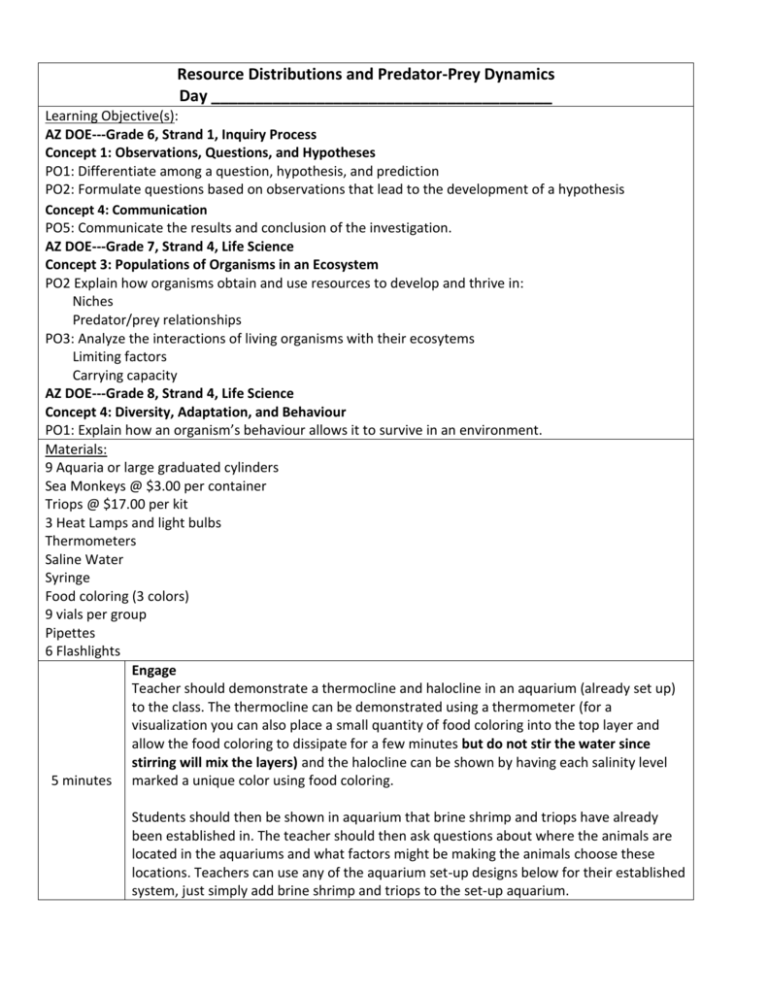
Resource Distributions and Predator-Prey Dynamics Day _______________________________________ Learning Objective(s): AZ DOE---Grade 6, Strand 1, Inquiry Process Concept 1: Observations, Questions, and Hypotheses PO1: Differentiate among a question, hypothesis, and prediction PO2: Formulate questions based on observations that lead to the development of a hypothesis Concept 4: Communication PO5: Communicate the results and conclusion of the investigation. AZ DOE---Grade 7, Strand 4, Life Science Concept 3: Populations of Organisms in an Ecosystem PO2 Explain how organisms obtain and use resources to develop and thrive in: Niches Predator/prey relationships PO3: Analyze the interactions of living organisms with their ecosytems Limiting factors Carrying capacity AZ DOE---Grade 8, Strand 4, Life Science Concept 4: Diversity, Adaptation, and Behaviour PO1: Explain how an organism’s behaviour allows it to survive in an environment. Materials: 9 Aquaria or large graduated cylinders Sea Monkeys @ $3.00 per container Triops @ $17.00 per kit 3 Heat Lamps and light bulbs Thermometers Saline Water Syringe Food coloring (3 colors) 9 vials per group Pipettes 6 Flashlights Engage Teacher should demonstrate a thermocline and halocline in an aquarium (already set up) to the class. The thermocline can be demonstrated using a thermometer (for a visualization you can also place a small quantity of food coloring into the top layer and allow the food coloring to dissipate for a few minutes but do not stir the water since stirring will mix the layers) and the halocline can be shown by having each salinity level 5 minutes marked a unique color using food coloring. Students should then be shown in aquarium that brine shrimp and triops have already been established in. The teacher should then ask questions about where the animals are located in the aquariums and what factors might be making the animals choose these locations. Teachers can use any of the aquarium set-up designs below for their established system, just simply add brine shrimp and triops to the set-up aquarium. Explore Each group of students should be given 8 vials of brine shrimp. You will want to roughly divide the total amount of brine shrimp by the number of students in your class so that each group will have 8 vials. Groups of students should then cycle through the 8 stations (thermocline, halocline, light on top of aquarium (bottom darkened), light on bottom of aquarium (top darkened), light at top and heat lamp, light at bottom and heat lamp, light at top and halocline, and light at 20 minutes bottom and halocline) and place the contents of one vial of brine shrimp in each aquarium. Nauplii should be slowly dripped into the aquaria by slowly pushing the nauplii out of a pipette against the side of the aquarium. Students should record their observations about where the brine shrimp go in each aquarium. Students will need to pay close attention to their brine shrimp to insure that they are following their own brine shrimp. If time permitting, you can have the students write down their observations in a class wide table of observations on the chalk board. You can then use this table to help further guide your questions in the section below. Explain The teacher should then ask the students why they think the brine shrimp are behaving this way? What factors are influencing the brine shrimp decisions? What other factors would also be important? Would other species of animals (i.e. predators) or more brine shrimp affect where the current brine shrimp want to be located? Definitions provided for food chain, community, halocline, thermocline, niche, predation (all terms in “terms list” below). 15 minutes Students asked to think about how these systems would be affected by a predator? Where would the predator want to be? Why? How would the predator’s presence affect the brine shrimp and where they want to be? Why? Note: Do not give them too much specific guidance regarding these questions in relation to their experiment in the expand section in order to allow the students to develop their own hypotheses. How is energy moving through these systems? Ask lots of questions here and really get the students involved. Expand Students should make a hypothesis about how one of these systems would be affected by the introduction of a predator. Once all of the groups have decided upon their hypothesis, the students should add triops to their tank of interest. Note: All groups with a hypothesis regarding a specific station must be present when the triops are added at that station. 25minutes Students should record their observations regarding the brine shrimps location before and after the addition of the triops as well as recording where the triops go within the aquarium. Students should take detailed observations of how the community dynamics and patch usages change with-in the tank. If time permitting, students should also be given a beaker of water from a fish tank that was inhabited by a fish to see how/if a top predator further changes the community dynamics and patch usage. Students should then draw conclusions based upon their observations and decide whether their hypothesis was supported or rejected. Evaluate Students should fill out a worksheet identifying the different steps they used in the scientific method to test their hypothesis (located below) 15minutes If time permitting, students should then orally present their findings to the class identifying how the brine shrimp assorted themselves under the different resource structures. Resource Distribution and Predator-Prey Dynamics: Pre-Class Procedure: 1. Set-up each station (instructions below). 2. Divide the nauplii out between different vials so that each lab group can have 8 vials. 3. Place triops into vials so that each group can have at least one vial. Station set-up Station 1: Thermocline 1. Set up a heat lamp above the aquaria. 2. Allow the upper water in the aquaria to increase in temperature and establish a thermocline. 3. Test the thermocline using a thermometer. Be careful not to stir the water with the thermometer Station 2: Halocline 1. Place a different color of food coloring in each of the different saline solutions 2. Very slowly, add each layer of water salinity to the aquarium using a pipette or syringe. Note: This will be a slow and tedious process that should take several minutes per layer. You will want to place the densest layer of water, the one with the highest level of salinity, on the bottom. The easiest way I have found to add the different salinities to the aquarium is by first adding the non-saline or least saline water first. Then using a very long syringe you can add the denser saline waters to the bottom of the aquarium by slowly dripping the saline water out of the syringe against the bottom of the tank. You will need to make sure to not have any air bubbles in your syringe before putting it in the tank. Optionally, you can also place a cotton ball at the bottom of the tank and then inject your syringe into the cotton ball if you find this method to be easier. Station 3: light on top 1. Place the aquarium in a darkened room or corner. 2. Place a flashlight (should not be one that gets hot) on the side of the upper portion of the aquarium. 3. Place a dark strip of paper below beam of light (from the flashlight) to block any light from going to the bottom of the aquarium Station 4: light on bottom 1. Follow same steps as Station 3 but place the flashlight on the side of the lower portion of the aquarium and the dark strip of paper above the beam of light. Station 5: Thermocline with light on top 1. Follow the steps under both Stations 1 (must use either an infrared or night black heat incandescent bulb) and 3. Station 6: Thermocline with light on bottom 1. Follow the steps under both Stations 1 (must use either an infrared or night black heat incandescent bulb) and 4. Station 7: Halocline with light on top 1. Follow the steps under both Stations 2 and 3. Station 8: Halocline with light on bottom 1. Follow the steps under both Stations 2 and 4. Terms and Definitions: Community: A general term applied to any grouping of populations of different organisms found living together in a particular environment Environment: The complete range of external conditions, physical and biological, in which an organism lives. Environment includes social, cultural, and (for humans) economic and political considerations, as well as the more usually understood features such as soil, climate, and food supply. Food chain: The transfer of energy from the primary producers through a series of organisms that are eaten, assuming that each organism feeds on only one other type of organism. At each stage much energy is lost as heat, a fact that usually limits the number of steps (trophic levels) in the chain to four or five. Halocline: A zone in which there are rapid, vertical changes in the salinity. In low latitudes the the halocline usually represents a decrease in salinity with increasing depth; in high latitudes it may represent the opposite. Niche: The functional position of an organism in its environment, comprising the habitat in which in organism lives, the periods of time during which it occurs and is active there and the resources it obtains there. Predation: The interaction between species populations in which one organism, the predator, obtains energy (as food) by consuming, usually killing, another, the prey. Salinity: A measure of the total quantity of dissolved solids in water, in parts per thousand (per mille) by weight, when all organic matter has been completely oxidized, all carbonate has been converted to oxide, and bromide and iodide to chloride. The salinity of ocean water is in the range 33-38 parts per thousand with an average of 35 parts per thousand. Thermocline: Generally, a gradient of temperature change, but applied more particularly to the zone of rapid temperature change between the warm surface waters (eplimnion) and coller deep water (hypolimnion) in a thermally stratified lake in summer. Trophic level: A step in the transfer of food or energy within a chain. There may be several trophic levels within a system, for example, *producers (autotrophs), primary *consumers (herbivores, and secondary consumers (carnivores); further carnivores may form fourth or fifth levels. All definitions from: Allaby, Michael. Oxford: Dictionary of Ecology. Oxford University Press. Oxford, England; 1994. Scientific Method Worksheet 1. Draw your observations regarding where the nauplii congregated at each station. 2. Why are the nauplii behaving in this manner? 3. As a result of your observations today, what are some examples of questions you had regarding how predators might influence the congregation of nauplii around the different resources (light, temperature, salinity)? 4. What was your hypothesis? 5. What was the prediction that you made for what would happen in your experiment? a. Was your prediction correct? b. Does this mean that your hypothesis was supported or rejected? c. Why? 6. What conclusions can you draw from this experiment? 7. How is the nauplii’s behaviour beneficial to their survival? 8. Now imagine another predator has been added to this system. How would this further change the community assembly within your system?

